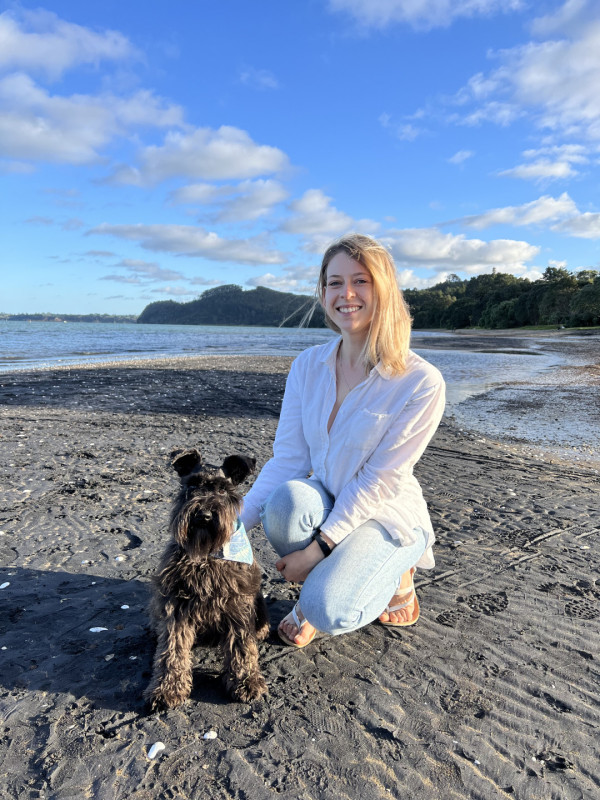Posted on 21 October 2021
Interview with: Eva Siwicka
Originally from Poland, Eva Siwicka moved to New Zealand in 2017 to complete her PhD with our Ecosystem services project. She completed the PhD in 2021 and is now continuing her research as leader of Modelling restorative economies project.
Tell us about your role in Sustainable Seas Challenge?
My PhD research looked at the small animals living in the seafloor of our intertidal sandflats and their role in regulating multiple ecosystem functions that we all benefit from. The results of my PhD show how important it is to understand complex relationships between nature and people to be able to maintain healthy coastal ecosystems and to manage them well.
It’s really exciting that I could continue developing the ideas that I started during my PhD, this time as a leader of the Modelling restorative economies project. My research strongly relies on knowledge sharing and bringing projects together by linking their different components: ecological, social, economic, cultural and legislative landscapes. Establishing those links will provide the roadmap to facilitate New Zealand’s restorative economies.
What are restorative economies?
Restorative economy is an approach to environmental management that assumes that an ecosystem is already degraded to some extent. The reality is that, sadly, we don’t have many pristine ecosystems left on Earth that we can preserve as they are. In most cases, our help to restore the ecosystem’s inherent functionality is necessary. This is central to ecosystem-based management (EBM) and restorative economies are a massive opportunity for the blue economy offering new investment opportunity and developing new sustainability practices, keeping the planet happy.
Restorative actions can be done in two ways: passive restoration, such as the creation of no-take zones, or active restorations that require activities that help ecosystems regenerate (like mussel reef restoration). My project looks at the latter.
How exactly is your project going to help active restorations?
Getting started with your own restorative action can be very difficult – where do you even begin?!
I am developing a digital tool that will allow people, organisations or businesses (potential investors) interested in starting their restorative action to explore the options available to them. The tool is going to consist of a short set of questions such as ‘what’s your location?’, ‘what’s the water clarity in your harbour?’ and so on.
The answer will tell potential investors what restorative actions have the highest probability of success. Furthermore, each action will be described in terms of the environmental, social, cultural and economic benefits, together with some guidance on what to do next.
This digital tool will be a stepping stone for investors to investigate options available to them and help them navigate the institutional maze. Can I ask you a question?
Sure.
Do you have a dog or have you ever thought about getting a dog?
Yes! It has always been my big dream.
So was mine! Dogs are the best. Before getting my dog, Chewie I wanted to know what breed would be suitable for me. I considered all sorts of things such as the dog’s energy level, size, intelligence, shedding. Can he stay home when I am at work? Should I adopt one from the shelter? Will I be able to afford to have a dog at all? There are so many things you need to know before committing to it. It can get quite overwhelming.
Choosing the right restorative action to suit your conditions and needs (including environmental, social, economic and cultural) is very similar in that sense! The digital tool I am developing will help you decide what action will be best for you. It will help you realise that Jack Russell Terrier is probably not the best choice if you don’t like to exercise and maybe English Bulldog will be a better option.
What is your definition of project success?
Spreading the word about active restoration and making New Zealanders realise that there are other ways of doing marine economy that are more sustainable from the environmental, social, cultural and economic points of view.
If you liked the dog analogy, the success for me would be drawing people’s attention to starting restorative actions in their harbours (getting a dog) in the first place rather than continuing doing economy in a standard way (getting a different pet). The digital tool will then help them decide what actions suit their requirements.
Eva and Chewie on Cornwallis Beach, Auckland. Taken by Pawel Szymonczyk.
About the project
Modelling restorative economies is bringing together research from across three of our active projects – Awhi Mai Awhi Atu, Ecological responses to cumulative effects, and Restorative marine economies – to determine the benefits of small-scale, community-based marine restoration initiatives. Scroll down to find the projects.
